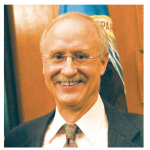To Get a PhD or Not to Get a PhD? Part 2
This column is written for statisticians with master’s degrees and highlights areas of employment that will benefit statisticians at the master’s level. Comments and suggestions should be sent to Megan Murphy, Amstat News managing editor, at megan@amstat.org.
The ASA Committee on Applied Statisticians gives you the experiences of four statisticians who took different paths after their master’s degrees. In October’s issue, we featured Kathryn M. Irvine, who earned her PhD. This month, Mark Otto explains why he took a different path after earning his master’s degree.
 Mark Otto is a statistical scientist with the Migratory Bird Program at the US Fish and Wildlife Service in Maryland. He is president-elect of the Washington Statistical Society and vice chair of the ASA Membership Council. He has a master’s in statistics.
Mark Otto is a statistical scientist with the Migratory Bird Program at the US Fish and Wildlife Service in Maryland. He is president-elect of the Washington Statistical Society and vice chair of the ASA Membership Council. He has a master’s in statistics.I backed into statistics from biology and graduated from North Carolina State University with a master’s. I couldn’t get a job in wildlife biology at a master’s-level pay grade, so I took a job with the Census Bureau. I had passed my written exams at the PhD level, so I could have returned to NC State without having to apply again. My graduate administrator, Tom Gerig, recommended I stay to get a doctorate. “You can work 10 or 11 years and have the same responsibilities but, after, you will be limited with just a master’s.”
I left for the Census and worked on seasonal adjustment and time series. My supervisors had us do research and talk on our work each year at JSM. I was able to take continuing education classes at JSM and through the Washington Statistical Society (WSS). I meant to go back to get a doctorate to build a stronger theoretical background and gain the tools needed to publish, but work and life got in the way.
I learned time series from two leaders in the field and, after 14 years, I took those skills to the Fish and Wildlife Service. I designed and analyzed bird surveys and built population models. My time series background helped. A growing group in the service developed and used structured decision-making; we built models and data to help our management and leaders solve difficult problems. It was a great opportunity to learn.
I also became involved with the WSS in quantitative literacy and mentoring. Then, I was asked to join the ASA Committee on Applied Statistics and worked on mentoring and statistical collaboration. Now I am ASA Membership Council vice chair and help our committees collaborate and work with the ASA Board. I have helped with the statistical leadership courses and taken advantage of my volunteer leadership opportunities. I was just elected WSS president for 2021. The lack of a PhD has definitely not interfered with my volunteer work or great opportunities outside my job!
After 20 years, I ran into Gerig at an NC State reunion. He was retiring. I brought up his advice about pursuing a PhD. He laughed, not remembering. “I said that,” he asked. “I always thought that master’s students were more employable!”



















Dear Colleague: Your resume as a working statistician is impressive.There are a few details on time series and their proper analysis in my book:”Interpreting Economic and Social Data -A Foundation of Descriptive Statistics” Published by Springer, 2009. More detail in click on ‘Authors-Academic’ then ‘Winkler’. Book also available in electronic form. Any interest? Let me know. Congratulations for your academic achievement on top of family and professional obligations. Best regards, Othmar